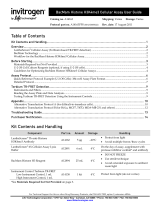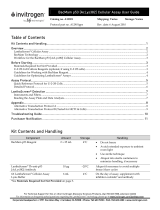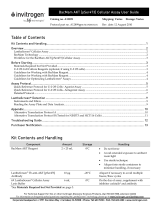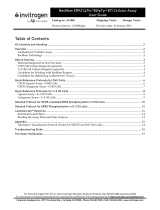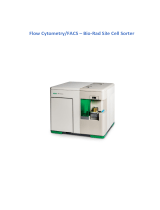Page is loading ...

Premo™ Autophagy Sensors
Catalog Numbers P36235, P36236, P36240, P36241, P36239
Pub.No. MAN0026683 Rev. A.0
WARNING! Read the Safety Data Sheets (SDSs) and follow the handling instructions. Wear appropriate protective eyewear,
clothing, and gloves. Safety Data Sheets (SDSs) are available from thermofisher.com/support.
Product description
Autophagy describes the sorting and delivery of cytoplasmic cargo, including proteins and organelles, for degradation by hydrolytic
enzymes through the lysosomal machinery. This pathway has been the subject of intense research to gain further insight into the role
basal autophagy plays in cell homeostasis and development (Figure1). Eorts are also directed to further elucidate the role of induced
autophagy as a cell survival response to stress, microbial infection, and disease (e.g., neurodegeneration, cancer) (Klionsky, 2007;
Mizushima, 2007; Rubinsztein et al., 2007).
Figure1Schematic depiction of the autophagy pathway in a eukaryotic cell.
The first step involves the formation and elongation of the isolation membranes or phagophore. The second step entails the expansion and
sequestering of the cytoplasm and formation of the double-membrane autophagosome and includes the association of the cytosolic LC3B
protein. Fusion of lysosomes with autophagosome to generate the autolysosome is the penultimate step. In the fourth and final phase, the cargo is
degraded.
The Premo™ Autophagy Sensor and Premo™ Autophagy Tandem Sensor Kits combine the selectivity of an LC3B- or p62-fluorescent
protein (FP) chimera or tandem RFP-GFP-LC3B construct with the transduction eciency of the BacMam 2.0 technology. BacMam
reagents (Baculovirus with a Mammalian promoter) are safe to handle (Biosafety Level 1) because they are non-replicating in mammalian
cells. They are also non-cytotoxic and ready-to-use. Unlike expression vectors, BacMam reagents enable titratable and reproducible
expression and oer high co-transduction eciency. Multiple BacMam reagents can therefore be readily used in the same cell.
Improvements made to the BacMam system, BacMam 2.0, enable ecient transduction in a wider variety of cells, including neurons
and neural stem cells (NSCs). The two-step protocol for imaging autophagy involves simply adding the BacMam 2.0 chimera or tandem
reagent to the cells, incubating overnight, and then visualizing transduction using standard GFP (green fluorescent protein) and/or RFP
(red fluorescent protein) settings.
Premo™ Autophagy Sensor LC3B-FP Kits
The LC3B protein plays a critical role in autophagy. Normally, this protein resides in the cytosol, but following cleavage and lipidation
with phosphatidylethanolamine, LC3B associates with the phagophore. This localization can be used as a general marker for autophagic
membranes (Figure1).
Each Premo™ Autophagy Sensor LC3B-FP Kit includes the BacMam LC3B-FP, a control BacMam LC3B(G120A)-FP, and chloroquine
diphosphate to induce autophagosomes (Figure2). The mutation on the control BacMam LC3B prevents its cleavage and subsequent
lipidation during normal autophagy, and protein localization remains cytosolic and diuse. Following treatment with chloroquine
USER GUIDE
For Research Use Only. Not for use in diagnostic procedures.

diphosphate, normal autophagic flux is disrupted and autophagosomes accumulate as a result of the increased lysosomal pH that
inhibits lysosomal fusion with the autophagosomes.
Figure2Autophagy detection with Premo™ Autophagy Sensor LC3B-GFP.
HeLa cells were plated into a 96-well plate at 5,000 cells per well and allowed to adhere overnight. Cells were then transduced with LC3B-GFP.
24 hours later, the cells were incubated with 50 µM chloroquine or left untreated (control) for 16 hours. Analysis was performed by quantifying
the fluorescence from vesicular structures in the perinuclear region using the Thermo Scientific™ Cellomics™ ArrayScan™ VTI platform with
Compartmental Analysis.
Figure3Spectra for Premo™ Autophagy Sensor LC3B-FP Kits.
Fluorescence excitation and emission spectra for Premo™ LC3B-Green Fluorescent Protein (LC3B-GFP, panel A) and Premo™ LC3B-Red
Fluorescent Protein (LC3B-RFP, panel B).
Premo™ Autophagy Sensor p62-FP Kits
The p62/SQSTM1 protein is a receptor for cargo destined to be degraded by autophagy, specifically cargo that is ubiquitinated
and serves to clear protein aggregates (Bjørkøy et al., 2005). The p62/SQSTM1 protein is able to bind both ubiquitin (Geetha and
Wooten, 2002) and the key autophagic marker ATG8/LC3 (Pankiv et al., 2007), thereby facilitating clearance of ubiquitinated proteins via
autophagy. Labeling of p62 serves as a useful marker for the induction of autophagy, clearance of protein aggregates, and the inhibition of
autophagy.
Each Premo™ Autophagy Sensor p62-FP Kit includes the BacMam p62-FP and chloroquine diphosphate for artificially generating
autophagosomes (Figure4).
Figure4Blockade of autophagy leads to an accumulation of p62-positive vesicles.
A549 cells were transduced with either the Premo™ Autophagy Sensor GFP-p62 or the Premo™ Autophagy Sensor RFP-p62 and cultured for
24 hours. Cells were then treated with either vehicle (water) or 60 µM chloroquine for an additional 16 hours. A549 cells were then labeled with
Hoechst™ 33342 and imaged using standard DAPI/FITC/Texas Red™ filter sets. The p62-positive spots were counted for each condition and for
each Premo™ Autophagy Sensor for 20 cells from two separate experiments.
2 Premo™ Autophagy Sensors User Guide

Premo™ Autophagy Tandem Sensor RFP-GFP-LC3B Kit
Single FP (fluorescent protein) chimeras such as the Premo™ Autophagy Sensor LC3B-GFP (Cat. No. P36235) or Premo™ Autophagy
Sensor LC3B-RFP (Cat. No. P36236) are useful for monitoring autophagosome formation, especially when combined with other FP
chimeras or fluorescent reagents. However, the use of a tandem FP construct allows an enhanced dissection of the maturation of the
autophagosome to the autolysosome (Geetha and Wooten, 2002; Pankiv et al., 2007). By combining an acid-sensitive GFP (i.e., Emerald
GFP) with an acid-insensitive RFP (i.e., TagRFP), the change from an autophagosome (neutral pH) to the autolysosome (with an acidic
pH) can be visualized by imaging the specific loss of the GFP fluorescence upon acidification of the autophagosome following lysosomal
fusion. Upon induction of autophagy, the Premo™ Autophagy Tandem Sensor labels the punctate autophagosomes; these structures are
positive for both GFP and RFP. Once the lysosome has fused, the pH drops, which quenches the GFP, making autolysosomes appear red
(Figure5 and Figure6).
Each Premo™ Autophagy Tandem Sensor RFP-GFP-LC3B Kit includes the BacMam RFP-GFP-LC3B and chloroquine diphosphate for
artificially generating autophagosomes. Following treatment with chloroquine diphosphate, normal autophagic flux is disrupted and
autophagosomes accumulate as a result of the increased lysosomal pH that inhibits lysosomal fusion with the autophagosomes.
Combining the Premo™ Autophagy Tandem Sensor with the far-red emitting LysoTracker™ Deep Red allows for a three-color analysis of
the autophagosomal/autolysomal/lysosomal dynamics.
Figure5The Premo™ Autophagy Tandem Sensor RFP-GFP-LC3B Kit allows for an enhanced dissection of the maturation of the
autophagosome to the autolysosome.
By combining an acid-sensitive GFP with an acid-insensitive RFP, the change from autophagosome (neutral pH) to autolysosome (with an acidic
pH) can be visualized by imaging the specific loss of the GFP fluorescence, leaving only red fluorescence.
Figure6The Premo™ Autophagy Tandem Sensor RFP-GFP-LC3B Kit can be used to discriminate between acidic and neutral
LC3B-positive vesicles.
HeLa cells were transduced with 40 particles per cell of the Premo™ Autophagy Tandem Sensor and cultured for 24 hours. Cells were then
incubated in either Vehicle, 90 µM Chloroquine, or 200 µM Leupeptin A for an additional 24 hours. Cells were imaged using standard FITC/TRITC
filter sets. Chloroquine blocks autophagy through neutralization of lysosomal pH; as a result, fluorescence is seen from both GFP and RFP,
reflected in a significantly higher number of GFP and RFP positive spots compared to vehicle treated cells. Leupeptin A blocks autophagy
without changing lysosomal pH; consequently, GFP fluorescence is lost in the acidic environment of the autolysosome whereas TagRFP retains
its fluorescence. Therefore, a significant increase in the number of RFP positive spots with a decrease in the number of GFP positive spots is
observed in Leupeptin A-treated cells.
Premo™ Autophagy Sensors User Guide 3

Contents and storage
Table1Premo™ Autophagy Sensor LC3B-FP Kits
Component Cat. No. P36235 Cat. No. P36236 Concentration Storage[1]
LC3B-FP (Component A) 1 mL (LC3B-GFP) 1 mL (LC3B-RFP) ∼1 × 108 viral particles/mL 2°C to 8°C
Protect from light
DO NOT FREEZE
Control LC3B(G120A)-FP
(Component B) 200 µL (LC3B(G120A)-GFP) 200 µL (LC3B(G120A)-RFP) ∼1 × 108 viral particles/mL
Chloroquine diphosphate
(Component C) 1mL 1mL 30‑mM aqueous solution ≤25°C
Protect from light
Approximate fluorescence excitation/emission maxima: GFP = 485/520nm; RFP = 555/584nm.
[1] When stored as directed, this kit is stable for at least 6months.
Table2Premo™ Autophagy Sensor p62-FP Kits
Component Cat. No. P36240 Cat. No. P36241 Concentration Storage[1]
p62-FP (Component A) 1 mL (GFP-p62) 1 mL (RFP-p62) ∼1 × 108 viral particles/mL
2°C to 8°C
Protect from light
DO NOT FREEZE
Chloroquine diphosphate
(Component B) 1mL 1mL 30‑mM aqueous solution ≤25°C
Protect from light
Approximate fluorescence excitation/emission maxima: GFP (TagGFP) = 483/506 nm; RFP (mKate2) = 588/633nm.
[1] When stored as directed, this kit is stable for at least 6months.
Table3Premo™ Autophagy Tandem Sensor RFP-GFP-LC3B Kit (Cat.No.P36239)
Component Amount Concentration Storage[1]
RFP-GFP-LC3B (Component A) 1mL ∼1 × 108 viral particles/mL
2°C to 8°C
Protect from light
DO NOT FREEZE
Chloroquine diphosphate
(Component B) 1mL 30‑mM aqueous solution ≤25°C
Protect from light
Approximate fluorescence excitation/emission maxima: GFP (Emerald GFP) = 488/509 nm; RFP (TagRFP) = 555/584nm.
[1] When stored as directed, this kit is stable for at least 6months.
Before you begin
Required materials not supplied
• Cell culture medium
Guidelines for working with BacMam reagents
• The following protocol is based on a 2‑mL labeling volume and ∼40,000 cells plated in a 35‑mm dish or one well of a 6-well culture
plate, with a particles per cell (PPC) of 30.
• For applications that require a larger number of cells, such as high-content screening (HCS), we recommend transducing the cells in
a 10‑cm dish or a T-75 flask and increasing the labeling volume to 10 mL with a proportionate increase in the volume of the virus.
Following an overnight incubation under normal growth conditions, trypsinize and count cells for distribution to appropriate plates at
cell number desired.
• If transduction eciency is low, you can alter the PPC, cell density, temperature, and incubation time or use cells at a lower passage.
• We recommend transducing cells at a confluency of ~70% for best results.
• For first‑time users of BacMam reagents, we recommend exceptionally well-transduced cells like U-2 OS.
• BacMam reagents typically do not eciently transduce hematopoietic-derived cells or cell lines.
4 Premo™ Autophagy Sensors User Guide

Transduce cells using BacMam 2.0 reagent
Transduce and image cells
Cells can be transduced with BacMam reagents while in suspension or after plating. For best results, add BacMam reagents to cells in
suspension at the time of plating.
1. Calculate the volume of the BacMam 2.0 LC3B-FP, p62-FP, or tandem reagent using the equation below:
mL of BacMam 2.0 reagent = (1 x 108 particles/mL)
(number of cells) (PPC)
where the number of cells is the estimated total number of cells at the time of cell labeling, PPC (particles per cell) is the number of
viral particles per cell, and 1 × 108 is the number of viral particles per mL of the reagent.
For example, to label 40,000cells with a PPC of 30:
mL of BacMam 2.0 reagent = (1 x 108 particles/mL)
(40,000) (30) = 0.012 mL (12 μL)
2. Mix each BacMam 2.0 LC3B-FP, p62-FP, or tandem reagent by inversion to ensure a homogenous solution.
IMPORTANT! Do not vortex the BacMam 2.0 reagent.
Note: Overexpression of LC3B has been shown to promote aggregation of this protein in a non-autophagic dependent manner
(Hailey and Lippincott‐Schwartz, 2009); for this reason, we recommend titrating the expression levels by varying the PPC.
3. Add the BacMam 2.0 LC3B-FP, p62-FP, or tandem reagent directly to the cells in complete cell medium and mix gently.
4. Plate the cells at the desired density if the BacMam 2.0 reagent was added to cells in suspension.
5. Incubate the cells overnight (≥16hours).
6. (Optional) Treat the control cells with 30–100 µM chloroquine (Component B) for 12–16hours.
Note: Drug treatments may be used to calibrate the system. Chloroquine (Component B) is an excellent drug to block autophagic
flux, which causes the accumulation of GFP- and TagRFP-positive vesicles. These protocols allow for the extent of bleed-through
and bleaching to be examined. Note that Chloroquine inhibits autophagy by neutralizing lysosomal pH. The hydrolases in the
lysosome require an acidic environment to function; even mild alkalinization inhibits these enzymes. Conditions that inhibit
the enzymes may not be sucient to alkalinize the autolysosomes suciently to rescue GFP fluorescence. For this reason,
chloroquine should be used at relatively high concentrations (>90 µM) for at least 12 hours. Leupeptin A or other drugs such
as an E64D/Pepstatin A cocktail inhibit lysosomal enzymes without aecting pH and can be used to block autophagy, resulting
in an accumulation of autolysosomes that maintain their acidity, thereby quenching GFP fluorescence. We recommend 200‑µM
Leupeptin A treatment for 18 hours. Under these conditions, cells with predominantly RFP-positive and GFP-negative vesicles
are seen when using the Premo™ Autophagy Tandem Sensor RFP-GFP-LC3B Kit. Earle’s Balanced Salt Solution (EBSS) nutrient
deprivation is also a useful control that allows for the progression from diuse GFP/RFP fluorescence to GFP/RFP-positive
autophagosomes, followed by RFP-positive autolysosomes.
7. Image the cells using the appropriate filters for GFP or RFP. Autophagosomes are typically located in the perinuclear region.
Note: The Premo™ Autophagy Sensor Kits were designed for use in live-cell imaging of autophagy. The cell-permeant nucleic
acid stains Hoechst™ 33342 and HCS NuclearMask™ Blue stains are spectrally compatible with the Premo™ Autophagy Sensor
fluorescence. Should you prefer fixed cell analysis, the fluorescence from GFP and RFP has been demonstrated to be resistant to
fixation with 4% formaldehyde and permeabilization with 0.1% Triton™ X-100. Fixation and permeabilization enables processing of
labeled cells with antibodies to other cellular targets. We recommend fixed cell format for large sample sizes, such as for HCS. Note
that the fixation treatment may need to be optimized, and that certain treatments may change the pH and thus alter the fluorescence
intensity of either fluorescent protein.
Note: Expression of exogenous autophagy markers can cause aggregation and false positives (Hailey and Lippincott‐Schwartz,
2009); this is especially true for p62 (Bjørkøy et al., 2009). Exogenous p62 is prone to form cytoplasmic bodies; however, these
bodies clear over time (Bjørkøy et al., 2009; Klionsky et al., 2012). Therefore, we recommend that the experiments are conducted 48
hours post-transduction.
Note: When using the Premo™ Autophagy Tandem Sensor RFP-GFP-LC3B Kit, be aware of bleed-through from one fluorescent
protein into the detection channel of another (Pankiv et al., 2007), especially with the excitation of TagRFP by GFP filter sets and the
Premo™ Autophagy Sensors User Guide 5

dierential brightness of GFP versus TagRFP. GFP and TagRFP also have dierential photostabilities. Therefore, artifacts caused by
photobleaching during time-lapse imaging should be taken into consideration.
Product list
Product Cat. No. Unit size
Premo™ Autophagy Sensor LC3B-GFP *BacMam 2.0* P36235 1 kit
Premo™ Autophagy Sensor LC3B-RFP *BacMam 2.0* P36236 1 kit
Premo™ Autophagy Sensor GFP-p62 P36240 1 kit
Premo™ Autophagy Sensor RFP-p62 P36241 1 kit
Premo™ Autophagy Tandem Sensor RFP-GFP-LC3B Kit P36239 1 kit
Limited product warranty
Life Technologies Corporation and/or its aliate(s) warrant their products as set forth in the Life Technologies' General Terms and
Conditions of Sale at www.thermofisher.com/us/en/home/global/terms-and-conditions.html. If you have any questions, please
contact Life Technologies at www.thermofisher.com/support.
References
Klionsky DJ. (2007) Autophagy: from phenomenology to molecular understanding in less than a decade. Nat Rev Mol Cell Biol. 8:931–937.
Mizushima N. (2007) Autophagy: process and function. Genes Dev. 21:2861–2873.
Rubinsztein DC, Gestwicki JE, Murphy LO, Klionsky, DJ. (2007) Potential therapeutic applications of autophagy. Nat Rev Drug Discov.
6:304–312.
Bjørkøy G, Lamark T, Brech A, Outzen H, Perander M, Overvatn A, Stenmark H, Johansen T. (2005) p62/SQSTM1 forms protein
aggregates degraded by autophagy and has a protective eect on huntingtin-induced cell death. J Cell Biol. 171:603–614.
Geetha T, Wooten MW. (2002) Structure and functional properties of the ubiquitin binding protein p62. FEBS Lett. 512:19–24.
Pankiv S, Clausen TH, Lamark T, Brech A, Bruun JA, Outzen H, Øvervatn A, Bjørkøy G, Johansen T. (2007) p62/SQSTM1 binds directly to
Atg8/LC3 to facilitate degradation of ubiquitinated protein aggregates by autophagy. J Biol Chem. 282:24131–24145.
Hailey DW, Lippincott‐Schwartz J. (2009) Using Photoactivatable Proteins to Monitor Autophagosome Lifetime, Methods Enzymol.
452:25-45,
Bjørkøy G, Lamark T, Pankiv S, Øvervatn A, Brech A, Johansen T. (2009) Monitoring Autophagic Degradation of p62/SQSTM1, Methods
Enzymol. 452:181-197
Klionsky DJ et al. (2012) Guidelines for the use and interpretation of assays for monitoring autophagy. Autophagy. 8:445–544.
Life Technologies Corporation | 29851 Willow Creek Road | Eugene, Oregon 97402 USA
For descriptions of symbols on product labels or product documents, go to thermofisher.com/symbols-definition.
Revision history:Pub.No. MAN0026683
Revision Date Description
A.0 15 June 2022 The format was updated and content from MAN0002600, MAN0007576, and MAN0007580 was combined.
The information in this guide is subject to change without notice.
DISCLAIMER: TO THE EXTENT ALLOWED BY LAW, THERMO FISHER SCIENTIFIC INC. AND/OR ITS AFFILIATE(S) WILL NOT BE LIABLE FOR SPECIAL, INCIDENTAL, INDIRECT,
PUNITIVE, MULTIPLE, OR CONSEQUENTIAL DAMAGES IN CONNECTION WITH OR ARISING FROM THIS DOCUMENT, INCLUDING YOUR USE OF IT.
Important Licensing Information: These products may be covered by one or more Limited Use Label Licenses. By use of these products, you accept the terms and conditions of all
applicable Limited Use Label Licenses.
©2022 Thermo Fisher Scientific Inc. All rights reserved. All trademarks are the property of Thermo Fisher Scientific and its subsidiaries unless otherwise specified.
thermofisher.com/support|thermofisher.com/askaquestion
thermofisher.com
15 June 2022
/




